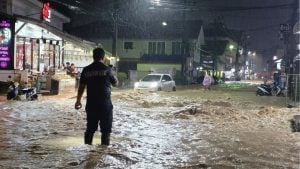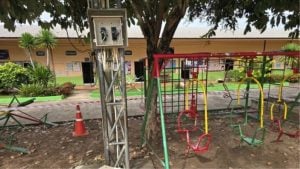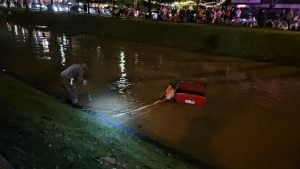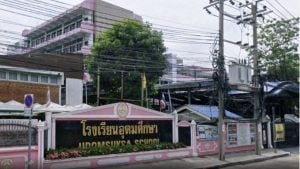Environment: Piscine pollution – killing fields
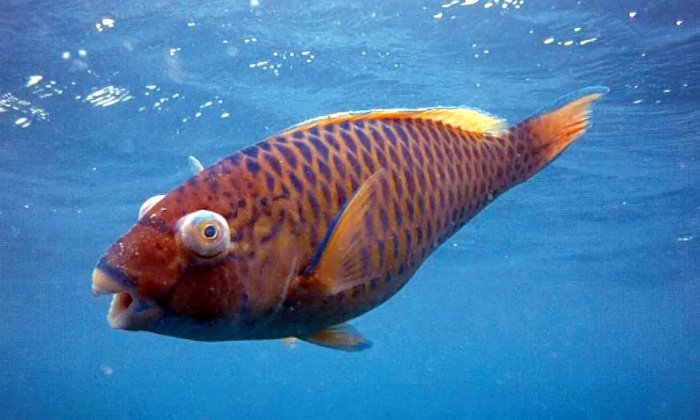
PHUKET: Some time ago a friend rang to say that the beach at Kata was littered with dead fish – mostly of an emerald green color. My guess was that they were reef-dwelling parrot fish and out of curiosity, I decided to venture down to Nai Harn Beach.
A scene of carnage awaited me; there were hundreds of very dead fish above the high water mark, bloated and fetid in the blazing afternoon sun. In one ten-meter stretch of beach, I counted 40 corpses. Like so much flotsam and jetsam, these bronze carcases were almost certainly surgeonfish or triggerfish – zoo plankton or algal feeders with characteristic deeply forked tail and stout rugby ball-shaped bodies.
Later I heard that similar scenes involving different dramatis personae had been enacted both at Kamala and Koh Racha Noi: witnesses noted parrot fish with bulging eyes swimming in disoriented circles.
Worryingly widespread, this episode suggested lethal contamination of a substantial area, perhaps 30 miles in extent, of the Andaman Sea. And worse, the area mainly affected seemed to be the coral reefs and their piscine inhabitants. What happened? Your guess is as good as mine. In the past, such episodes have spawned official refutations of likely causes: toxic dumping; the illegal use of dynamite or cyanide; or the release of uncontrolled effluents.
 A variety of reef fish were found dead and then documented by a local diving instructor, while reports of more dead fish rolled into the Gazette.
A variety of reef fish were found dead and then documented by a local diving instructor, while reports of more dead fish rolled into the Gazette.In this particular case, the Phuket Marine Biological Center (PMBC) stated that autopsies on the victims revealed no obvious clues, stating, “The results were inconclusive… we have yet to determine the cause of death.”
So here’s my take on the topic. In this writer’s humble estimation, the slaughter was a likely consequence of the recent abnormally high rainfall, with overloaded wastewater systems; storm drains at bursting point; and domestic emissions and raw sewage entering the rivers and the ocean.
It has happened before, usually at this time of year, and until Phuket adopts more stringent building laws – especially sensible limits on high-rise, high-density apartments and starts effectively to protect forests and mangrove swamps, and above all develops adequate waste and sewerage facilities – it will happen again… and again.
A major factor in oceanic contamination worldwide is a procedure known as “eutrification,” a polite word for the harmful consequences of nutrients, sometimes in the form of chemical fertilizer, being rashly applied to commercial crops, or indeed, to garden plants in order to increase yields or vigor. In periods of extreme precipitation, these substances are subsequently leached from the soil, and ultimately find their way into the sea – a sink for everything that mankind seeks clandestinely to jettison.
Put another way, it is the process whereby run-off from agricultural practices – in the form of both spraying and feeding, as well as from so-called developments and their inadequate septic systems – enters our waterways, or seeps through the soil in the form of sludge and gradually contaminates the ground water. Loaded with these man-made nutrients, and with fewer trees, mangrove swamps and marsh vegetation to help absorb, filter and neutralize these noxious man-made products, Mother Earth finally disgorges them into the sea.
And that is without taking into account what is euphemistically called “point source pollution”. If you don’t know what this is, look around the beaches and rocky outcrops of Phuket’s shoreline at low tide and you will see raw sewage pipes snaking out into the ocean. Only recently, black rivers of sludge have invaded beaches at Koh Racha and Karon. No prizes for guessing where all that comes from.
As if that were not enough, Phuket has other features, some of them peculiar to this island, which exacerbate the problem. Dotted around the place are man-made lakes, the legacy of centuries of tin mining. The water and surrounding areas have long been contaminated, and not just by metallic residues such as particulate waste – so called acid mine drainage – but by suspended sediments, and worse by sulphates and poisonous chemicals, sometimes found in conjunction with tin.
Add to these a number of other local pollutants: the spoil from Phuket’s insatiable building activities, routinely

dumped on the surrounding soil; the slow percolation of methane from decaying waste in landfill sites (Phuket generates 800 tonnes of garbage per day); and the likely impact of indiscriminate shrimp farming, which not only uses chemical fertilizers and antibiotics, but has annexed many hectares of mangroves – and you have some inking of the gravity of the issue.
The cumulative impact of all these activities on the local marine environment is self-evidently disastrous. One effect has been a periodical increase in algal bloom or phytoplankton. With more so-called nutrients to feed their habit, algae proliferate and thrive. On occasions, these blooms are so concentrated, they can change the actual color of the sea. Often these algal eruptions are toxic.
But harmful or not, when these micro-organisms die, they deplete the water of oxygen and contribute to the condition – as does the discharge of suspended sediment and waste into unclouded seas. Known as hypoxia, this condition causes fish to suffocate and damages precious and delicate ecosystems such as coral reefs.
In my estimation the most plausible reason for the sudden and recent demise of so many marine creatures is linked to this concoction of noxious brews. Either the fish were exposed to unacceptable levels of contamination from any number of possible sources; were feeding on toxic micro-organisms; or were suffering from a lack of life-giving oxygen.
In this connection, it is worth noting that some of the casualties apparently showed symptoms of asphyxiation, with their gills clamped tightly to their sides. In a global context, it has been estimated that recovery from the damage meted out to our seas from eutrification will take – wait for it – 1,000 years to repair…
So there are a number of identifiable villains in this doleful scenario: and all are alive and flourishing in Phuket. One is domestic and industrial garbage and sewage in its various manifestations, another is chemical compounds such as phosphates from detergents, and a third is stuff applied to the land in the form of insecticides, herbicides and fertilizer. It is in this last category that gardeners can maybe lend a small helping hand by avoiding over-zealous applications of chemical nutrients or pesticides on our flower beds and instead, attempting where possible, to use organic alternatives. More than 95 per cent of sprayed insecticides and herbicides reach a destination other than their intended targets.
And consider this: commercial granulated fertilizer contains three elements: nitrogen, phosphate and potassium. Of these, phosphates and to a lesser extent nitrogen, are absolutely key players in the process of eutrification, in the pollution of our once pristine seas.
If we all cut down on the use of phosphates alone, we might – just – help arrest a process whereby our seas are being defiled, maybe might even save the lives of a few precious trigger, parrot and surgeonfish.
— Patrick Campbell
Latest Thailand News
Follow The Thaiger on Google News:









